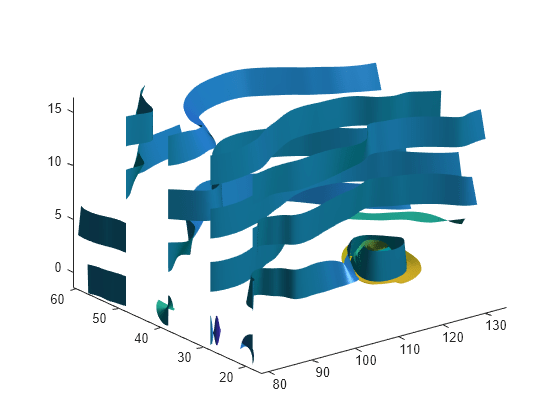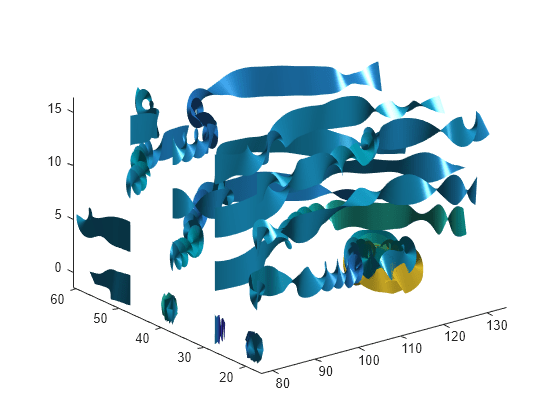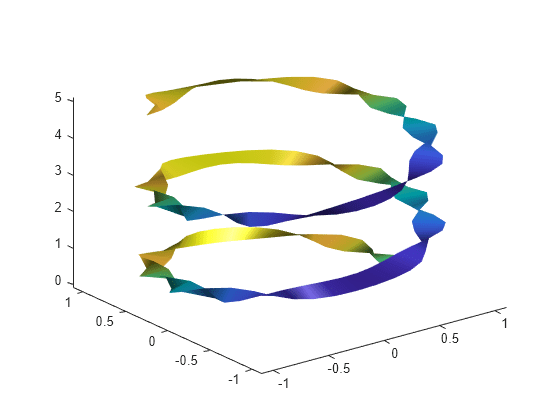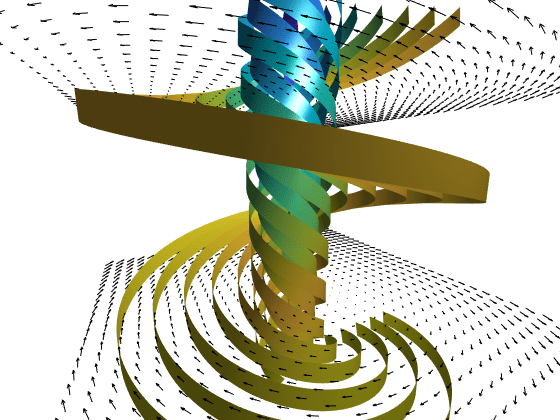streamribbon
3 次元ストリーム リボン プロットのベクトル ボリューム データからの作成
構文
streamribbon(X,Y,Z,U,V,W,startx,starty,startz)
streamribbon(U,V,W,startx,starty,startz)
streamribbon(vertices,X,Y,Z,cav,speed)
streamribbon(vertices,cav,speed)
streamribbon(vertices,twistangle)
streamribbon(...,width)
streamribbon(axes_handle,...)
h = streamribbon(...)
説明
streamribbon(X,Y,Z,U,V,W,startx,starty,startz) は、ベクトル ボリューム データ U、V、W からストリーム リボンを描画します。
U、V、W の座標を定義する配列 X、Y、および Z は、単調でなければなりませんが、等間隔でなくても構いません。また X、Y、および Z は、meshgrid で作成されたかのように、同じ数の要素が含まれていなければなりません。
startx、starty、および startz は、ストリーム リボンの開始位置をリボンの中心に定義します。
リボンのねじれは、ベクトル場のカールに比例します。リボンの幅は、自動的に計算されます。
streamribbon(U,V,W,startx,starty,startz) は、X、Y、および Z が以下の式によって決定されると仮定します。
[X,Y,Z] = meshgrid(1:n,1:m,1:p)
ここで [m,n,p] = size(U) です。
streamribbon(vertices,X,Y,Z,cav,speed) は、事前計算済みの流線頂点、回転角速度、フロー速度を前提としています。vertices は、流線頂点の cell 配列 (stream3 により生成) です。X、Y、Z、cav、および speed は、3 次元配列です。
streamribbon(vertices,cav,speed) は、X、Y、および Z が以下の式によって決定されると仮定します。
[X,Y,Z] = meshgrid(1:n,1:m,1:p)
ここで、[m,n,p] = size(cav) です。
streamribbon(vertices,twistangle) は、リボンのねじれ (ラジアン単位) に、ベクトルの cell 配列 twistangle を使用します。vertices と twistangle にそれぞれ対応する要素のサイズは、等しい必要があります。
streamribbon(...,width) は、リボンの幅を width に設定します。
streamribbon(axes_handle,...) は、現在の axes オブジェクト (gca) ではなく、ハンドル axes_handle をもつ axes オブジェクトにプロットします。
h = streamribbon(...) は、surface オブジェクトのハンドル (開始点ごとに 1 つ) のベクトルを返します。
例
拡張機能
バージョン履歴
R2006a より前に導入





